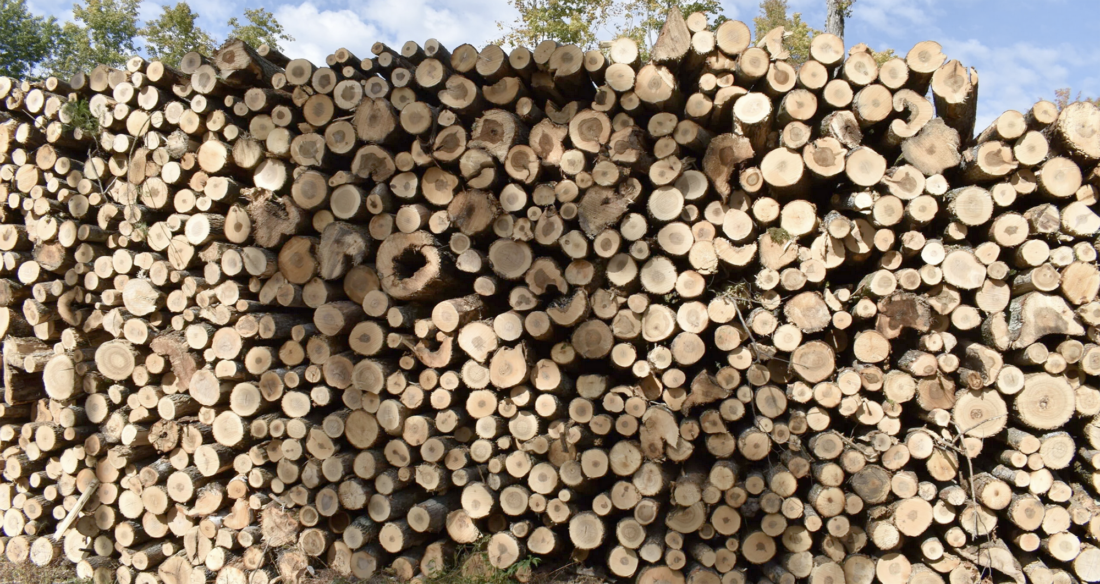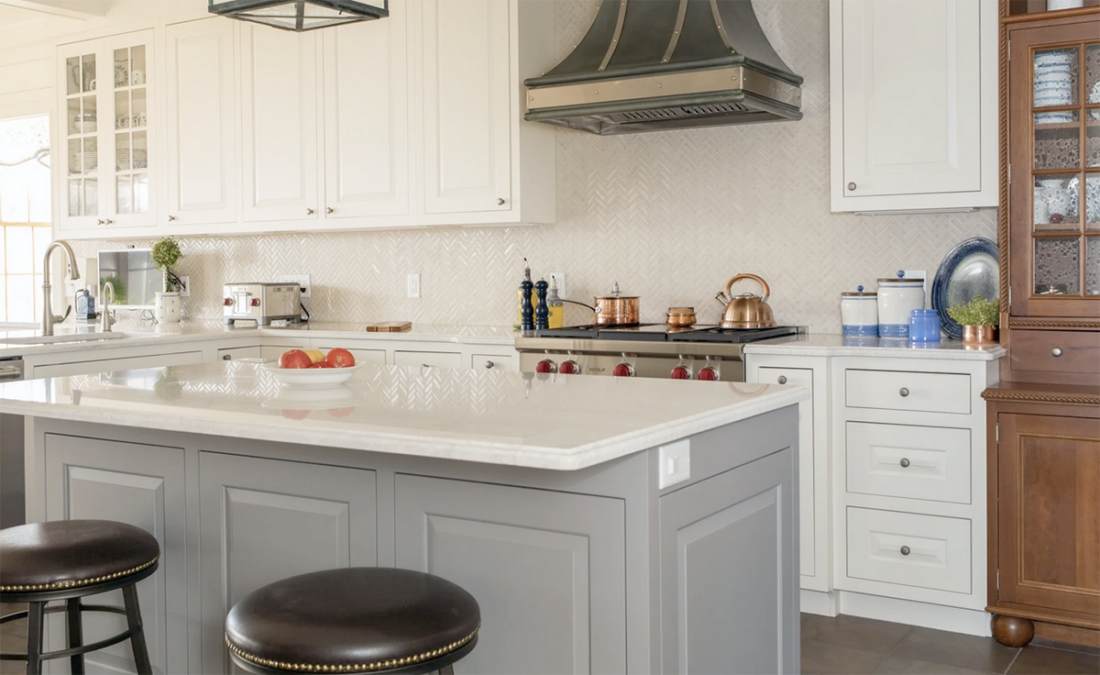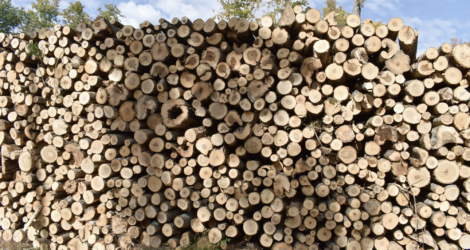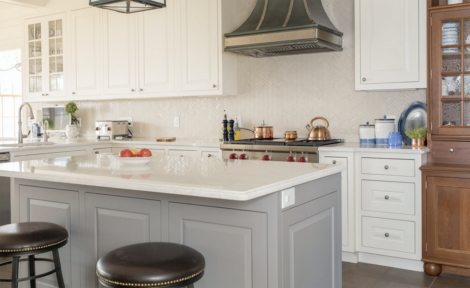Tariffs on wood, wood products might not help producers
- Mixed hardwood timber is stacked at a logging site in Elcho, Wis., in September 2021. (Rob Mentzer/Wisconsin Public Radio)
- Kitchen cabinets designed by Curran Cabinetry & Design in Madison, Wis. (Photo courtesy of Curran Cabinetry & Design)

Mixed hardwood timber is stacked at a logging site in Elcho, Wis., in September 2021. (Rob Mentzer/Wisconsin Public Radio)
Larry Krueger has already felt the effects of President Donald Trump’s tariffs on his lumber business.
Krueger, cofounder and vice president of Krueger Lumber in Valders in northeast Wisconsin, said with tariffs in place on lumber imported to the United States, other countries have responded with reciprocal tariffs. This has led to an excess of lumber in Wisconsin, with fewer places to sell it to.
“Demand is way down. Prices are way down. And the consequences can be found by seeing all the sawmills and lumber companies go out of business,” Krueger told WPR’s “Wisconsin Today.” “We have cut down production, and we are at risk. You can go through the news and find quite a few sawmills that have gone out of business. Some flooring mills have gone out of business. The wood market in general is very depressed.”
Last week, the U.S. added 10% tariffs to imported timber and lumber. The New York Times reported that imported kitchen and bathroom cabinets now have a 25% tariff and will increase to 50% on Jan. 1. Upholstered furniture now has a 25% tariff that is scheduled to increase to 30% Jan. 1.
In a Sept. 29 proclamation, Trump argued that “wood production in the United States remains underdeveloped. At the same time, imports of wood products continue to rise, signaling foreign dependence and creating vulnerabilities in the domestic industry.” The president blamed mill closures and unemployment in the lumber industry on imports.

Kitchen cabinets designed by Curran Cabinetry & Design in Madison, Wis. (Photo courtesy of Curran Cabinetry & Design)
Krueger said the reality of the industry and the possible effects of tariffs are complicated.
“The United States in general, and Wisconsin in particular, are huge agriculture producers. We produce more grain, more soybeans and more wood than we consume,” Krueger said. “So we do always need to sell some of our product overseas, simply because we produce so much. If we can’t sell it overseas, that product has to stay here, and that kills the price.”
Krueger logs and processes mainly hardwoods, which are used to make flooring, furniture and cabinets, among other things. The U.S. Forest Service and the state Department of Natural Resources both report hardwoods such as oak, maple and cherry are the most abundantly produced wood in Wisconsin. The United States does import a significant amount of softwood, with 80% coming from Canada. Softwoods, which include pines, spruces and firs, are used more for construction framing and roofing and to make pallets and paper, among other things.
Krueger immediately saw effects of the tariff war when it started in the spring. He had three shipping containers on their way to China, and the customer there canceled the order.
“We ended up paying thousands of dollars to bring those containers back to our sawmill,” Krueger said. “It was a huge cost to us.”
Allen Curran owns the Madison-based Curran Cabinetry & Design, which custom-designs cabinets and furniture for homeowners and contractors and then works with Amish carpenters to build them. His company competes with overseas manufacturers in China and Southeast Asia who are often using American wood.
“A lot of the wood product that goes into those cabinets are shipped from the United States to Southeast Asia, fabricated, finished, boxed, and then sent back to the United States. And still it’s oftentimes at a lower price point than what we’re able to produce here in the United States,” Curran said.
While it might seem like tariffs on American companies like Curran’s would benefit from high tariffs on imported wood products, Curran said it remains to be seen. He said the National Kitchen & Bath Association, of which he’s a member, has decreased the industry’s sales projections for the year by 5 to 7%.
“When you’re dealing with tariffs, you really don’t know what the full effects are going to be until after it’s happened. And even at that point, it’s sometimes down the road before the full effect takes place,” Curran said. “A lot of people have to wait and see, which is difficult for forecasting sales and planning for the future, because you just don’t know what the sales volume is going to be.”
With the tariffs in place, Curran’s company is also paying more for many parts it uses. Most of the hardwood the company uses comes from American lumber mills. But it also uses plywood from Canada and imported metal handles and hinges that go on cabinets. Tariffs have increased the company’s cost for these parts, Curran said.
Business owners call for more nuanced trade tactics, predictability
Krueger said tariffs can be used to help United States companies, but he argued they should be used in a more targeted way.
“A more judicious application of them might be what’s in order,” he said. “To blanket tariff a country, you hit the good, the bad and the indifferent.”
Curran said companies like his need more consistency from the United States’ trade policies.
“These peaks and valleys are killing us. We can’t plan for the future,” he said. “We don’t know what to do with staffing. We just added another employee on the hope that things go well. When you’re in business, one of your costs is going to be labor. … If you don’t know what to expect down the road, the cost of training labor is so high and takes so long, it’s very difficult to plan for the future.”




